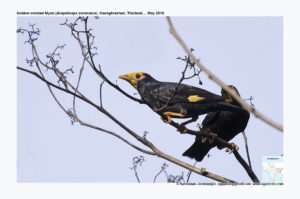
Golden-crested Myna Ampeliceps coronatus
Etymology:
- Ampeliceps : Greek word ampelion – unknown small bird.; Latin word ceps– headed,
- Coronatus : Latin word for Crown derived from corona – crown
Vernacular Names: Cachar: Dao myna raja, Hindi:Sonmukut Myna
Distribution in India: Resident of Assam and Manipur in India.
Description: Size of 19–21 cm; Wt. of 78–99 g. It is a medium-sized myna with short square-ended tail, and stiff feathers at base of upper mandible directed forwards over nostrils, bare skin around eye and extending back to form point behind eye. The male has a golden-yellow forehead to crown and nape forming crest, and extending anteriorly down to chin and center of throat. The rest of plumage is black, glossed with purple on side of face, mantle and chest, glossed blue-green on rump and upper belly. The wing is black, white patch on inner web of outer six primary feathers, yellow patch on outer web of primaries P4-P9; tail is black; iris is dark brown, bare skin around eye is yellowish-pink; bill is yellow, lower mandible has bluish base; legs are dull orange. The female is like male but with less gold on head, and with only narrow central strip of golden-yellow on chin and throat. The juvenile is duller and browner than adult, with pale lores, wing patch and throat, faintly streaked below. It acquires golden-yellow feathers gradually.
Habitat: It is found in lowland evergreen forest, also deciduous and mixed woodland, open forest, and cleared areas with tall trees. It is found from lowlands and foothills up to 800 m.
Food habits: It eats fruits and insects. It forages in pairs or in small groups, primarily in canopy.
Breeding habits: They breed in Apr–Aug. They are monogamous. The nest is a rough lining of grass in tree hole above ground. They lay a clutch of 3–4 eggs. The incubation is done by female alone. The Incubation period is 14–15 days. The chicks are fed by both parents. The young fledge after 25–26 days.